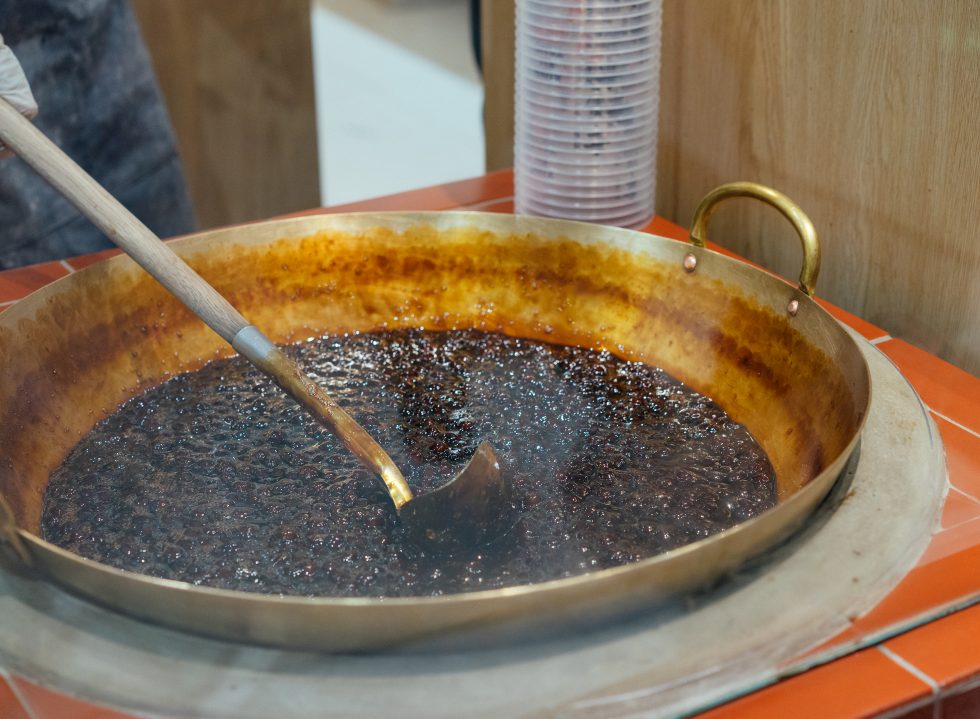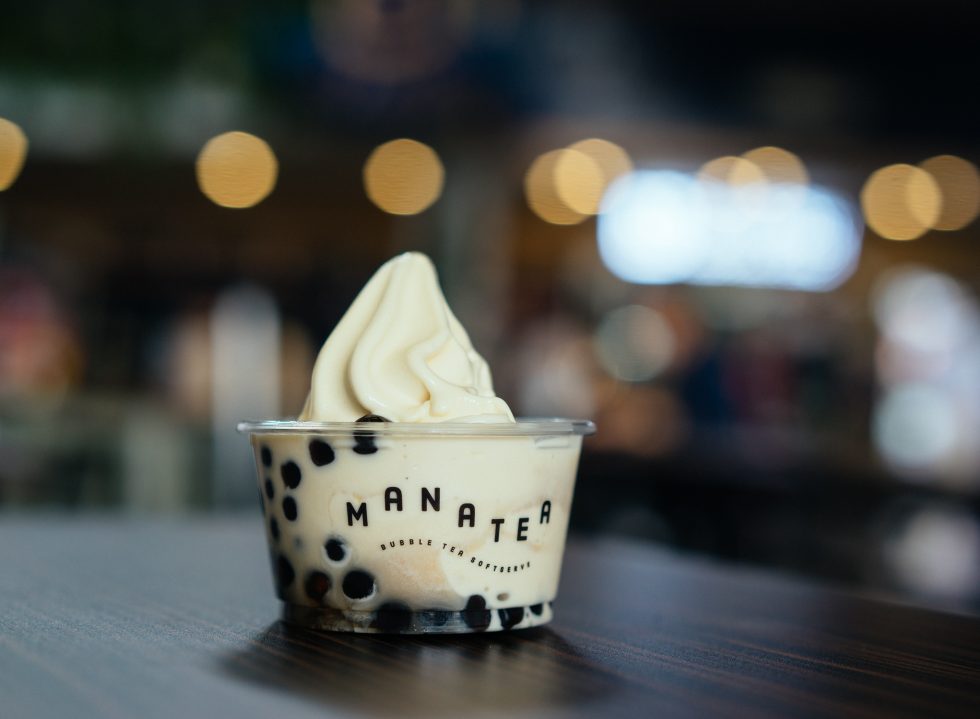Which of these require a double take: a 14-year-old girl from China hospitalised for hundreds of undigested tapioca pearls in her system, or the existence of boba-infused dishes that take in forms of pastry, cocktail to sushi? To a non-convert, both may sound downright bizarre. But in reality, these are the outcomes of an all-sweeping trend that has been taking on a life of its own in the past year or so.
Boba, or bubble tea as it’s also known for, is barely a new thing. But being off radar for some time does make the current phenomenon looks as if they were a treasure hunt, including in Jakarta where the trend has swept in fast. Soon enough, lengthy queues in front of bubble tea shops and food delivery drivers carrying bundles of bubble tea became a common sight.
Where it started
There’s much speculation as to whom invented the famed beverage. But rumour has it that the Chun Shui Tang Teahouse in Taichung, Taiwan, has laid claim on the origins. As reported by journalist Derrick Chang of CNN, the teahouse was the first purveyor of iced tea back in the early ‘80s after the founder, Liu Han-Chieh, saw how coffee is served cold in Japan. The fusion of tapioca pearls only happened later on, when Liu’s product manager mixed them in her iced tea for fun and turned out enjoying the novel twist.
Today, bubble tea shops inhabit nearly every corner of Taiwan’s street and menu. They are also spread in neighbouring countries like Japan, South Korea, China, and eventually to the rest of the world, ours included.
When talking about the old-time greats, Quickly doesn’t pass by anyone living in Indonesia. Opened in 2000, it became the country’s first bubble tea shop after the Taiwan brand made a name in California. A phenomenon themselves, they had the Indonesian line up for their range of milk teas; take Taro Milk Tea, the brand’s mainstay that still reels in its fame until today. There’s also Chatime, another Taiwan-based flagship that saw growing numbers since it first opened in Jakarta in 2011; currently, the brand has over 200 outlets across the country.
Here, there, everywhere
The arrival of Quickly and Chatime in Jakarta created waves, but they are tame compared to the spiking trend that is seen right now.
According to the data gathered by GrabFood, the food delivery handle of the ride-hailing and payment app giant, Grab, Indonesians order an average of three cups of bubble tea per month from the app. This is lightweight, considering the result is limited to one company’s data, when in fact bubble-tea drinkers, like Aya Cendana, a self-proclaimed boba fan, admits to consume up to 3-4 times a week with her peers or by herself.
Aside from the more established players such as Quickly, KOI Thé and Chatime, a crop of international and home-grown brands has pierced through the Indonesian market with such ease, arriving with new variations and concoctions that stirred the local scene.
Friendly to the ears are brands such as Taiwan’s own Xing Fu Tang and Tiger Sugar, who opened their stores in Jakarta early this year. Flock of patrons waiting in front of their outlets have become public knowledge as they order what the two brands are best known for: Brown Sugar Milk Tea. Both shot to popularity with their stir-fried brown sugar pearls that are made from scratch, ladled into their signature fresh milk and tea drink, yielding a beverage described as a creamy treat with hints of smokey caramel and the coveted chewy pearls.
Up in people’s alley recently too is the White Rabbit Candy Milk Tea, whose flavour is a nostalgic ode to the milky taste of the iconic taffy-like candy from China. Popularised by Heycha, a local chain inspired by Guangdong’s Heytea, the packaging even has the candy’s wrapper paper plastered on the cup as a nod to the original sweet treat.
Even with its experimental flair, Heycha, which specialises in cheese tea, had a tough start when they first opened in 2018. “At the time, cheese milk tea and even bubble tea wasn’t a thing. But this year feels different,” said Elleina Christiono, founder of Heycha.
The brand relies heavily on trends and aims to always be the first to bring new kinds of beverages to revel on. Even with their innovative White Rabbit Candy Milk Tea, Elleina didn’t believe that the trend would last. “It will go down sooner or later. But if we can keep our consistency, maybe we can be like Chatime, who has been in the industry for years. The key is to monitor the trend and ensure quality through it all.” But so far, the future looks good on their part. Selling up to 300 cups on average per day, what could be more telling than that?
All-around influence
There’s no doubt that the bubble tea hype is fuelled by social media. Much like the nation’s past obsession with es susu kopi, the hunger for content and the desire to create an Instagram-tailored aesthetics has reignited public’s interest in the beverage.
Quick to hop on the idea is ZODIAC, Senopati’s music bar and mini nightclub, who recently introduced five customised Boba-cocktails in collaboration with Quickly. The drinks boast a balance of the brand’s signature flavours and alcohol, and were successful to draw many spectators to come back for more; amongst the stand outs is the Sugahill Taro, a mix of Quickly’s Taro Milk Tea with notes of bourbon, topped with tapioca pearls.
“The reaction has been awesome! We sold out almost every weekend,” said Salmaa Chetizsa, a rep from ZODIAC. “The fact that we created our own version of the notable Quickly glasses cups makes the hype even more interesting; it’s cute and it hits the nostalgic aspect of it. But instead of purchasing it in malls, people are being served these boba cocktails in a bar, under disco balls.”
There’s also the artisanal bakery, BEAU, who infuse tapioca balls, sourced directly from Taiwan, onto their pastries and goods, such as the BEAU-BA Pancake and the BEAU-BA French Toast.
Owner and founder Talita Setyadi can vouch for their popularity, especially for the BEAU-BA Pancake which coincided with the grand opening of the bakery’s second outlet in Panglima Polim. “It was great for us to generate crowd and hype for our store. But at BEAU bakery, we also focus on creating the best balance of flavours, as well as executing our dishes well, as to not disappoint our customers,” showing that it’s not just about the hype, but also creating a fusion that complements each other.
The unique inventions didn’t stop there, as something as savoury as sushi have also become boba-fied, like the three new dishes created by Baiza Sushi (who claims to be the first sushi establishment to labour on the concept, as per their Instagram bio): they are the Salmon Salad Boba, Mango Sticky Sushi and the Spicy Salmon Roasted Boba. “They went viral in the blink of an eye. Many media and food bloggers tried out of curiosity and reacted well as the mix of textures surprisingly connects well,” said Rosa Janna, a rep for Baiza Sushi. “Our new dishes are an instant boost for social media traffic. We joined the craze to fit in with the hype, fully knowing that it would lead to that.”
Not much surprise here when numerous other F&B establishments have decided to tap into the hype and make a pretty penny with it, too. All sorts of variations inspired by the chewy bubbles have been created to gain traction, from the baked cheese tart boba and kue cubit boba, to the peculiar one of all, mie goreng boba.
The good, the bad, the ugly
The future of the trend is as good as anyone’s guess, but what’s certain is that the hype has made room for business opportunities, from entrepreneurs opening its own chains to F&B businesses diversifying their menu by incorporating the essence of Boba. The crowds at the Boba Fest 2019 back in September at Gandaria City Mall proved that not only people are fully immersed, but the number of boba tenants have swelled in a relatively short amount of time.
Tony Hutagalung, a senior corporate legal who treats himself to a mere 4 or 5 bubble teas a month, also noticed this surge. But as a consumer, one concern that’s been on Tony’s mind is the lack of environmentally friendly packaging that comes with buying bubble tea. “I do worry about the possible increase of plastic waste from these disposable plastic cups, and how it could be a challenge for these brands moving forward, since I think the business is not slowing down anytime soon.”
With this kind of millennial-driven trend, it’s only natural for businesses alike to introduce eco-conscious solutions. This is something that Chatime already gone for by accepting the use of personal containers instead of single use cups, while KOI Thé accepts the use of their customised tumblers. To par, reusable bubble-size straws have become a standard inclusion in metal straw packs, encouraging consumers to be environmentally-conscious without sacrificing the drinking experience of bubble tea. Time will tell if more and more brands would shift to the same method, but this seems to be the route that businesses would consider going forward.
Another concern that has emerged is the halal-ness of bubble tea for Muslim consumers. Only recently, debates in Malaysia are happening in furor where ingredients and methods are questioned regarding their compliance with the Islamic-doctrine. As a Muslim-majority country, we are prone to reflect the same considerations and sentiments. So far, brands like Chatime have ensured its clientele that all their ingredients are halal as they don’t contain both gluten, gelatin and animal products, while Xing Fu Tang Indonesia is reported to be in the process of certifying it.
But the question remains: how would bubble tea fare in the future? Would they be placed in the same pedestal as the es kopi susu phenomenon in Indonesia? Tony says otherwise. “Maybe for short-term alternative but for the long-term, I gotta say no. Coffee has its own appeal and has been part of our culture since long ago.”
Aya agrees. “I don’t think Boba can ever replace coffee. They can’t give people the energy spike that coffee can. The [boba] hype rests on the branding, packaging and the continuous innovative products. That’s why they keep attracting a lot of people.”
These sentiments resonate with how trends typically work. Specific to boba, the beverage might have prolonged life in East Asia where tea culture is particularly strong. But in Indonesia, milking a trend has become the way we react towards a particular novelty. One cannot deny that the soaring bubble tea hype is thanks to the genuinely tasty beverage, boosted by the sharing culture on social media that hooked many. The fact is that businesses and consumers have taken the Boba phenomenon to heart, and no matter how silly they sound, it’s a further confirmation just how deep we are in this hole.
















